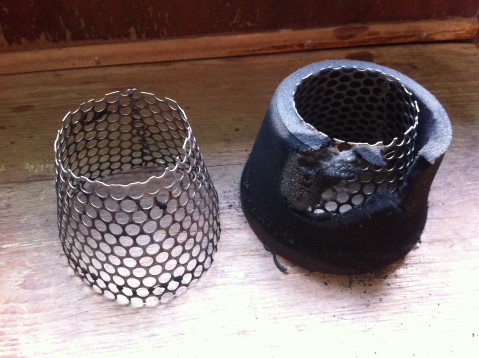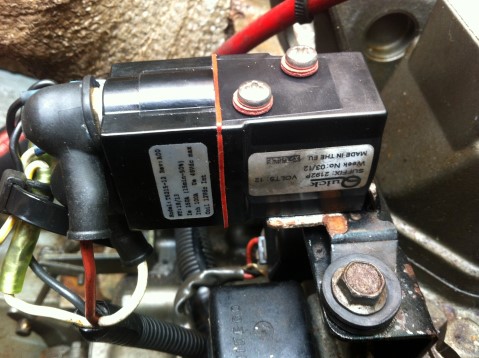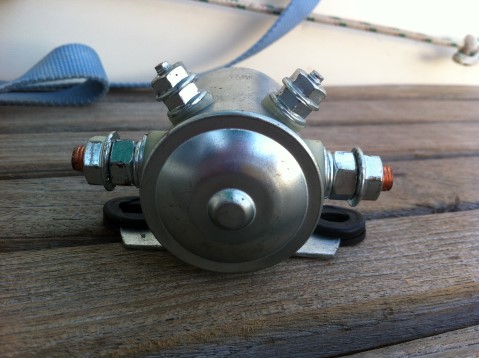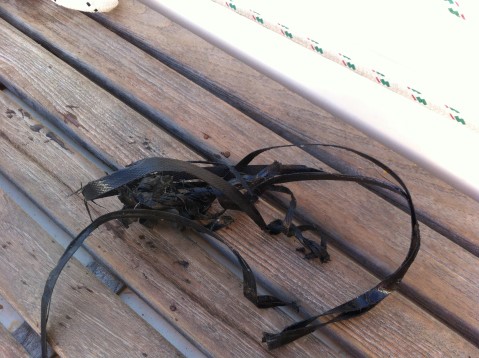
Sailing Vessel Beruta Ship's Log
La Linea - Las Palmas

11 October 2014
A day before my fourth Transatlantic I biked to Gibraltar to buy some spares for Yanmar like belts and filters. Especially I wanted to get the air filter because  the foam from mine was completely sucked in the cylinders! People familiar with the matter told me that it happened because the foam was dirty and the increased air pressure torn it down to small pieces. I was lucky that it did not damage the engine. After I read in Cadler's boat bible that many engines did not have air filters, I thought that I would just go without it. But a friend warned me that I would lose the motor in 30-50 hours. It would become practically irrepairable because the cylinders are very expensive to fix. A Yanmar dealer did not have the air filters, so I had to cover the metal mesh with a mosquito net and a foam from a cushion attaching them with a superglue. I was able to find
the foam from mine was completely sucked in the cylinders! People familiar with the matter told me that it happened because the foam was dirty and the increased air pressure torn it down to small pieces. I was lucky that it did not damage the engine. After I read in Cadler's boat bible that many engines did not have air filters, I thought that I would just go without it. But a friend warned me that I would lose the motor in 30-50 hours. It would become practically irrepairable because the cylinders are very expensive to fix. A Yanmar dealer did not have the air filters, so I had to cover the metal mesh with a mosquito net and a foam from a cushion attaching them with a superglue. I was able to find  a pre-starter relay,
a pre-starter relay,  the one that I had replaced in July. It failed again. Last time it cost me around 40 euros in Azores. In Gibraltar I paid 72! It was different one, made in Italy rather than China. Will see how long it lasts. I also replaced the engine's fuel filter and both belts.
the one that I had replaced in July. It failed again. Last time it cost me around 40 euros in Azores. In Gibraltar I paid 72! It was different one, made in Italy rather than China. Will see how long it lasts. I also replaced the engine's fuel filter and both belts.
12:00 local time (UTC+2). Filled the canisters with diesel, paid for two days at the marina and headed to Gran Canaria. The tricky moment was to find out the correct current in Gibraltar straight. The chart said "High Water in Tarifa - 3 hours: eastward, High Water in Tarifa + 3 hours: westward". In a reality it was the opposite! High water in Tarifa was at 17:00 but at noon the current was already westward. It became eastward around 19:00. I had checked the current when I was coming to La Linea from Ibiza two days ago. At noon, it was westward and the high water in Tarifa was an hour later meaning that the westward current started before the high water hour, probably 3 hours prior to it.

I made a quick stop in Tarifa to pick up Fernando who was eager to cross the Atlantic ocean with me. Fernando wanted to learn to sail, get experience and earn nautical miles that were necessary for his further yacht training. He completed his day skipper course but had very limited sailing experience to date. Welcome, Fernando!
I thought that I could dock to a fuel station but I did not find one in the port. There was only one sailboat near the travel lift and many small fishing boats. I decided to go to the end of a pier, the only wall available and relatively easy to come along. Fernando arrived on a bus couple of minutes later.
We continued the voyage to Las Palmas together. The wind and current were still following us. Only when 5 miles were left to the Moroccan corner, the current changed and slowed Beruta down by 3 kts. Soon the wind became on the nose too.
I really did not know what Fernando had done in his past that the God sent the worst weather to us that I hadn't seen since my stay in Malta 3 years ago. In a weather forecast, the wind was 15-20 kts but in fact it blew 25-30 gusting to 40 kts during squalls! I took two reefs on the main sail and hoisted the storm jib, which I had not been using for a long time. During the first two squalls I pulled the main down but later I did not even bother because the squalls were quite short and as soon as the main was down, so was the squall.
Initially we had agreed to take 3-hour watches while sailing near Moroccan coast but Fernando got sea-sick and I had to stay up all night dealing with the bad weather.
12 October 2014
The strong head wind continued next day. The squalls came out off the blue skies. Were they what were called white squalls? After a squall passed there were few minutes with weak variable wind but because the seas were big, I had to turn the engine on to help Beruta move through the waves.
For the last 24 hours we passed just 100 miles tacking, not much, even less on the course to Canaries. Here is the position at 11:00Z. As you see, the distance to Las Palmas is 700 miles, which normally takes 6 days of sailing, but we are going to have the head wind most of the time or very little wind at all later when we come to Canary Islands. Therefore, it would probably take us 7 or 8 days to get there.
In the evening I received weather faxes from the Boston's broadcast station in MA, 48 and 96-hour wind-wave forecasts, surface analysis and tropical cyclone danger area. The signal from New Orlean's one was very weak.
The cold front created by the low pressure area centered near Gibraltar was going to pass Beruta sometime tomorrow, in the late evening or at night. On the image you may see that at 12:00 UTC October 14, 2014 it has already moved the to the African shore. In the GRIB file the head wind was 15-20 kts during that night. We are going to see what it would be in a reality. Obviously, the apparent wind gusts may be over 30 kts.
13 October 2014
I changed the computer time to UTC. At 10:00 or 48 hours after I started the voyage, the track distance was 208 nm. 522 nm left to Las Palmas. Here is the Beruta's position at this time. Sunny. 10 kt head wind. Motoring at 4.5-5 kts on the 230° course. My barometer showed 766 mm. In the GRIB file it was 763 mm. I could already see heavy clouds on the horizon, indicating the approach of the cold front.
The forecast for the next 48 and 96 hours was not favorable. Still the SW wind, 10 kts on October 15 and 15 kts on October 17.

14 October 2014
The front actually passed us between 5 and 6 o'clock. As you see, the gale was just north of Beruta. All night the head wind was 25-30 kts gusting to 35. When it started raining, the wind calmed down to 10-20, changed direction a little bit but generally became variable. It was difficult to sail under such conditions; therefore, I continued motoring with half main up.
For the last 24 hour we made another 100 miles or so. The distance to Las Palmas now was 430. Another 4 days of motor-sailing, I suppose (if amount of the fuel permitted such pleasure).
On the positive note, Fernando was not sea-sick anymore and probably began enjoying the voyage.
Around noon the skies cleared and the wind became more stable. It was possible to use genoa and full main to help Yanmar with a fuel consumption.
At 19:00Z there were 7 gallons of diesel in the tank. I poured 25 gallons from the canisters in. One full canister was left as a reserve. With the full tank we should be ok for 3 days.
This evening I was not able to receive the weather forecast due to weak radio signal.

15 October 2014
At night I woke up because the sails were flapping - the wind died completely. I had to pull them down, just left half of the main to reduce the rolling.
After the breakfast, the dolphins came to entertain Fernando. I had an idea to stop and swim with them. Fernando jumped into the water with a mask but dolphins stayed at a distance and did not come close anymore. After a little while, they disappeared. Nevertheless, the swimming was useful as Fernando found  a plastic line on the propeller shaft. He was able to remove it with a help of a knife.
a plastic line on the propeller shaft. He was able to remove it with a help of a knife.
Later in the day the wind picked up to 5-7 kts, 60-90° on the starboard side. I hoisted the genoa and began undoing the reefs on the main but it did not go. The first slider was torn off the luff and stuck in the mast. The only way to get it down was... you guess it correct - to climb the mast! I took my ascenders and Fernando was winching the other halyard attached to the bosom-chair just in case the first halyard breaks. Good that the waves were small and rolling was not too bad. I hammered the slider down and after a beer or two that helped me figure out what kind of tape to use and where to find it,  sew the slider back to the luff. Sorry, we forgot to make a fascinating picture of me up the mast in the Atlantic.
sew the slider back to the luff. Sorry, we forgot to make a fascinating picture of me up the mast in the Atlantic.
The weather forecast for the next 48 hours: very little or no wind at all. We entered the high pressure area centered on Canary Islands.
16 October 2014
In the morning I pulled the genoa down. There was no wind. After my yoga, we stopped for the swimming. It could be the beginning of a new tradition - go diving in the morning to remove the rubbish from the propeller. Today it was some plastic net that Fernando spotted with a mask. The water was cool and refreshing, not to say unbelievably clear!
At 10:00Z the GPS track showed 535 nm. 215 nm left to Las-Palmas. 115 to Puerto Carmen on Lanzarote. We would go there if we ran out of fuel.
48-hour wind forecast predicted 10 kts SW wind at noon - the time we should have arrived to Las Palmas. For tomorrow there would be the same mirror-like Atlantic ocean.
At 22:00Z I changed the course to Lanzarote, the island closest to Beruta where we could get the diesel to continue to Las Palmas. Optimistically we had not had to alter the route. We had just enough fuel to reach Gran Canaria. The deviation from the course was not significant, so there was no good reason to take the risk to run out of fuel just a 30 minutes before an anchorage or even worse - stall the engine during anchoring.

17 October 2014
In the morning we were already sailing along the coast of Lanzarote to Puerto Calero. We first passed Arrecife, the capital of the island where I had anchored 3 years ago, then Puerto del Carmen, a popular resort with numerous hotels and long beaches. At 14:00Z we docked at the fuel station in the marina. The diesel was the cheapest in Europe, slightly more than 1 euro per liter. We took approximately 200 liters. We also filled Beruta with water.

It was about 100 miles to Las Palmas from Puerto Calero. The was very little wind 4-6 kts 30-60° on the starboard. When we were sailing between the islands, Lanzarote on the north and Fuerteventura on the south, we helped a bit with full sails but at night the waves became bigger and I had to pull the sails down to stop them from flapping.
I downloaded the GRIB files to my iPhone for the Canary Islands. Still no wind for the next 3 days.
Here was the position of Beruta at 22:00Z.
18 October 2014
11:00Z we entered the harbor of Las Palmas and dropped the anchor in front of the beach behind the marina.
All pictures from Las Palmas are on Google Photos.

